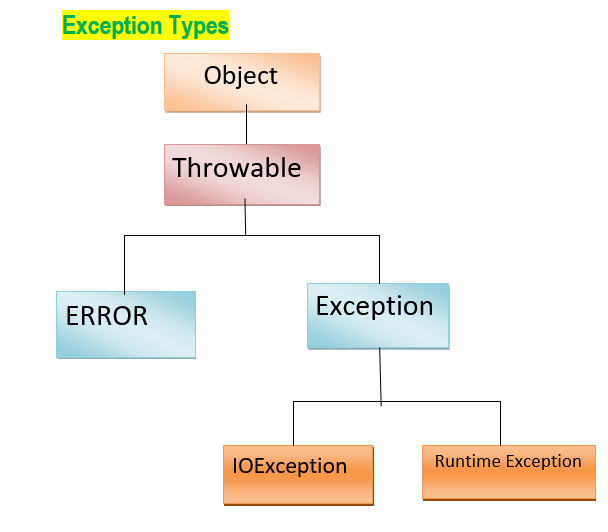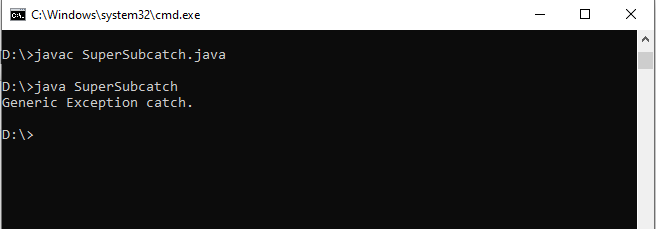Exception Handling
Exceptions
can be generated by the java run-time system.Java Exception handling is managed
via five keywords: try,catch,throw,throws, finally
This is the
general form of an exception-handling block:
try {
//block of code
to monitor for errors
}
catch(Exception Type1 exOb) {
//exception
handler for Exception type1
}
catch(Exception Type2 exOb) {
//exception
handler for Exception type2
}
// …
finally {
//block code to
be executed before try block ends
}
class ExcO {
public static void
main(String args[]) {
int d =0;
int a =42/d;
}
}
Java.lang.ArithmeticException:/by Zero
At exc0.main(exc0.java:4)
Using try and catch
Example
File name: TryDemo.java
class
TryDemo
{
public static void main(String args[])
{
int d=0;
int a;
try { // monitor a
block of code.
a= 42 / d;
System.out.println("This will not be printed");
}catch (ArithmeticException e)
{ //catch
divide-by-zero error
System.out.println("Division by Zero");
}
System.out.println("After
catch statement");
}
}
The output appears as
given below:
Multiple catch clauses
Example
File name: MutipleCatch.java
class
MutipleCatch {
public static void main(String args[])
{
try
{
int a =args.length;
System.out.println("a
= " +a);
int b=42/a;
int c[] ={1};
c [42] = 99;
}catch(ArithmeticException e) {
System.out.println("Exception Occurred:"+e);
}catch(ArrayIndexOutOfBoundsException e)
{
System.out.println ("Exception
Occurred:"+e);
}
System.out.println("After
try/catch blocks.");
}
}
The output appears as
given below:
A=0
Divide by 0:java.lang.ArithmeticException: / by zero
After tey/catch blocks.
C:\java MultiCatch TestArg
A=1
Array index oob: java.lang.ArrayIndexOutOfBouundsException: 42
After try/catch blocks.
Example
/*This program contains an error.
A subclass must before its superclass in a series
of catch statement. if
not, unreachable code will be created and a compile-time error will result.
*/
class
SuperSubcatch {
public static void main(String
args[]) {
try
{
int a=0;
int b=42/a;
}
catch(Exception e) {
System.out.println("Generic Exception catch.");
}
/*This catch is never reached because ArithmeticException is a subclass
of Exception.
catch(ArithmeticException e) {//ERROR - unreachable
System.out.println("This is
never reached") ;
} */
}
}
Output
Throw
Throw ThrowableInstance;
//demonstrate throw
/*Program to illustrate throw clause*/
File name: ThrowDemo.java
import java.io.*;
class ThrowDemo
{
public
static void main(String args[]) throws Exception
{
int
number=15;
try
{
if(number>10)
throw new Exception("Maximum
limit is 10");
}
catch(Exception e)
{
System.out.println("Exception has been Occured"+e.toString());
}
finally
{
System.out.println("This is the last statement");
}
}
}
OUTPUT(java
ThrowDemo 20)(success)
File name: ThrowDemo.java
import java.io.*;
class ThrowDemo
{
public
static void main(String args[]) throws Exception
{
int
number=Integer.parseInt(args[0]);
try
{
if(number>10)
throw new Exception("Maximum limit is 10");
}
catch(Exception e)
{
System.out.println("Exception has been Occured"+e.toString());
}
finally
{
System.out.println("This is the last statement");
}
}
}
Output
Throws
File name: ThrowsDemo.java
class ThrowsDemo{
public static void main(String args[]) throws
ArithmeticException{
System.out.println("inside main");
int a=0;
int j=40/a;
System.out.println("This statement is not
printed");
}
}
Output
Finally
Finally
creates a block of code that will be executed after a try/catch block has
completed and before the code following the try/catch block.
File
name: FinallyDemo.java
class FinallyDemo{
static void procA(){
try{
System.out.println("inside procA");
throw new RuntimeException("demo");
}finally{
System.out.println("procA's finally");
}
}
static void procB(){
try{
System.out.println("inside procB");
return;
}finally{
System.out.println("procB's finally");
}
}
static void procC(){
try{
System.out.println("inside procC");
}finally{
System.out.println("procC's finally");
}
}
public static void main(String args[]){
try{
procA();
}catch(Exception e){
System.out.println("Exception caught");
}
procB();
procC();
}
}
Output








0 comments:
Post a Comment